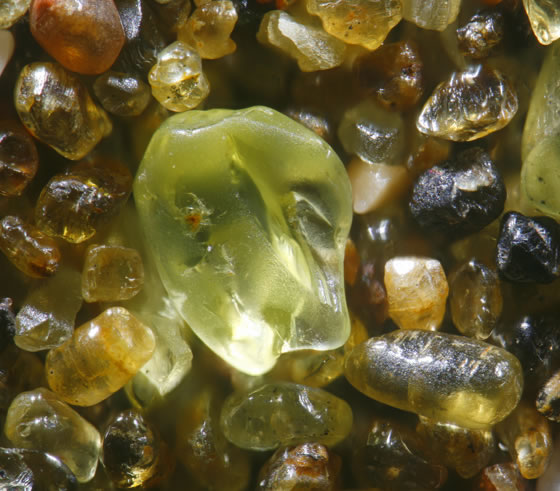Home » Rocks » A Grain of Sand Picture Gallery
A Grain of Sand Picture Gallery
A gallery of interesting and colorful sand grains from around the world.
Images and captions by Dr. Gary Greenberg, Author of A Grain of Sand

In the image above, the tip of a spiral shell has broken off and become a grain of sand. It is opalescent from the repeated tumbling action of the surf. Surrounding the shell fragment are five other sand grains, from top middle clockwise, (1) a pink shell fragment, (2) a foram, (3) a microscopic shell, (4) a volcanic melt, and (5) a bit of coral.
Image Copyright 2008 Dr. Gary Greenberg, All Rights Reserved.
| When viewed on your computer's monitor, the sand grains in these images will be magnified between 30 and 300 times their actual size. Sand grains are particles of loose sediment that range between 1/16 and 2 millimeters in diameter. |

Sand from Skeleton Beach in Namibia contains rounded and polished pink-and-red garnet.
Image Copyright 2008 Dr. Gary Greenberg, All Rights Reserved.

Sand from Zushi Beach, Japan, contains what looks like a sapphire crystal. The crystal is larger than the surrounding grains and has survived eroding because of its hardness and quality.
Image Copyright 2008 Dr. Gary Greenberg, All Rights Reserved.

The glacially deposited sands around Lake Winnibigoshish, Minnesota, contain abundant sediments from the igneous and metamorphic minerals of the Lake Superior basin. A sample includes pink garnets, green epidote, iron-rich red agates, black magnetite, and hematite.
Image Copyright 2008 Dr. Gary Greenberg, All Rights Reserved.

A chabazite crystal was found in sand from Diamond Head, Oahu, Hawaii.
Image Copyright 2008 Dr. Gary Greenberg, All Rights Reserved.

The beautiful green sand on Lumahai Beach, Kauai, Hawaii, is composed of pieces of bright-green olivine.
Image Copyright 2008 Dr. Gary Greenberg, All Rights Reserved.

Sand from Plum Island, Rowley, Massachusetts, contains garnet, magnetite, and epidote.
Image Copyright 2008 Dr. Gary Greenberg, All Rights Reserved.

A bright sand grain from Tamarindo Beach, Guanacaste Province, Costa Rica, is made of chabazite—a glassy, cubic mineral belonging to the zeolite family of silicates.
Image Copyright 2008 Dr. Gary Greenberg, All Rights Reserved.
About the Author
Artist/scientist/inventor Gary Greenberg combines his passions for art and science, creating dramatic photographic landscapes of everyday objects. Originally trained as a photographer and filmmaker, at the age of 33, he moved from Los Angeles to London, to earn a Ph.D. in biomedical research from University College London. Dr. Greenberg was an Assistant Professor at the University of Southern California during the 1980's, and in 1990, he began inventing and manufacturing high-definition three-dimensional light microscopes.
For the past six years, Greenberg has focused his microscopes on common objects, such as grains of sand, flowers, and food. These everyday objects take on a new reality when magnified hundreds of times. His images of sand make us realize that as we walk along a beach we are strolling on millions of years of biological and geological history. He believes that art is a window through which we can appreciate the miracles of nature.
Dr. Greenberg was a featured artist at the Science Museum of Minnesota. His exhibit, "Exploring the Microscopic World of Sand Grains" ran from May 2008 through January 2010. He has written a fascinating book about sand grains through the microscope: A Grain of Sand: Nature's Secret Wonder, Voyageur Press, Minneapolis, 2008. Visit his website at sandgrains.com
|
Dr. Gary Greenberg's book, "A Grain of Sand: Nature's Secret Wonder" is available from many booksellers and online retailers. The images on this page are a small sample of what is presented in the book.
Dr. Greenberg gave us a copy of his book for review and gave us permission to share these images with Geology.com visitors.
| More Rocks |
 |
Tumbled Stones |
 |
Fossils |
 |
Geodes |
 |
The Rock Used to Make Beer |
 |
Topo Maps |
 |
Difficult Rocks |
 |
Fluorescent Minerals |
 |
Sliding Rocks on Racetrack Playa |

Find Other Topics on Geology.com:

|

| ||

|

| ||

|

| ||

|

|

